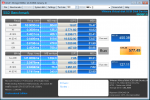Hi all,
I've been using FreeNAS on and off for the last few years and I am currently in the process of starting a hosting company. In this case, I am looking to build a NFS which is capable of high IOps together with being simple to manage.
I found FreeNAS pretty promising because of the easy webgui (yet still able to do advanced stuff), because of ZFS (i've used this on ubuntu for a long time and pretty satisfied with it) and because of the monitoring possibilities. I will be replicating pools to a second box at some point as well.
This NFS server will be handling a lot of pxe-booting systems which will mainly be hosting minecraft servers so a lot of 4K stuff. It will also be hosting a single 1T datastore for my 2 ESXi-boxes. I've heard lots of bad stories about FreeNAS + NFS + ESXi so I suppose I will go with iSCSI. I've already conducted my own tests with NFS to ESXi and was far from impressed - I have yet to try iSCSI. I'm planning to have a dataset for each purpose so it's separated as well. Now, I already have some decent hardware which will be running this box but I'm searching the guidance from experts on how to set it up correctly. Here's my current hardware:
SuperMicro X9DRi-F (dual 2011 mb, dual gbit lan)
Xeon E5-2603 QC processor
64GB DDR3 ECC memory
4 x 2T 7,2K RPM SATA HDD's
Extra Intel DP Server adapter (2x gbit lan)
Redundant 620W powersupply
I want this system to be as fast as it can, so I've thought about throwing in a couple of NVMe SSD's to accellerate the pool. My question is, how much is sufficient? I am especially looking at write performance here and especially 4K wise. The minecraft servers will be writing and loading 4K stuff so it's important for me that the performance is there. I've been looking at the Samsung 950 pro 256gb drive. I already have one of those so I wouldn't have a problem chippin' in another. My idea is to partition them each with 2x100gb partitions and leave the rest for overprovisioning. Then mirror partition 1 on the SSD's for ZIL and mirror them as well on partition 2 for L2ARC. For L2ARC though, would it make more sense to chip in an extra 64gb of memory? I have a lot of different information as well telling me that more RAM gives better writes, where other information says it does not. What's the deal here?
I hope some of you might be able to guide me in the direction of getting the best performant FreeNAS box. :) MB/s does not matter to me, the only thing I'm out after is the raw 4k/8k IOps.
Thanks in advance,
Chris
I've been using FreeNAS on and off for the last few years and I am currently in the process of starting a hosting company. In this case, I am looking to build a NFS which is capable of high IOps together with being simple to manage.
I found FreeNAS pretty promising because of the easy webgui (yet still able to do advanced stuff), because of ZFS (i've used this on ubuntu for a long time and pretty satisfied with it) and because of the monitoring possibilities. I will be replicating pools to a second box at some point as well.
This NFS server will be handling a lot of pxe-booting systems which will mainly be hosting minecraft servers so a lot of 4K stuff. It will also be hosting a single 1T datastore for my 2 ESXi-boxes. I've heard lots of bad stories about FreeNAS + NFS + ESXi so I suppose I will go with iSCSI. I've already conducted my own tests with NFS to ESXi and was far from impressed - I have yet to try iSCSI. I'm planning to have a dataset for each purpose so it's separated as well. Now, I already have some decent hardware which will be running this box but I'm searching the guidance from experts on how to set it up correctly. Here's my current hardware:
SuperMicro X9DRi-F (dual 2011 mb, dual gbit lan)
Xeon E5-2603 QC processor
64GB DDR3 ECC memory
4 x 2T 7,2K RPM SATA HDD's
Extra Intel DP Server adapter (2x gbit lan)
Redundant 620W powersupply
I want this system to be as fast as it can, so I've thought about throwing in a couple of NVMe SSD's to accellerate the pool. My question is, how much is sufficient? I am especially looking at write performance here and especially 4K wise. The minecraft servers will be writing and loading 4K stuff so it's important for me that the performance is there. I've been looking at the Samsung 950 pro 256gb drive. I already have one of those so I wouldn't have a problem chippin' in another. My idea is to partition them each with 2x100gb partitions and leave the rest for overprovisioning. Then mirror partition 1 on the SSD's for ZIL and mirror them as well on partition 2 for L2ARC. For L2ARC though, would it make more sense to chip in an extra 64gb of memory? I have a lot of different information as well telling me that more RAM gives better writes, where other information says it does not. What's the deal here?
I hope some of you might be able to guide me in the direction of getting the best performant FreeNAS box. :) MB/s does not matter to me, the only thing I'm out after is the raw 4k/8k IOps.
Thanks in advance,
Chris

